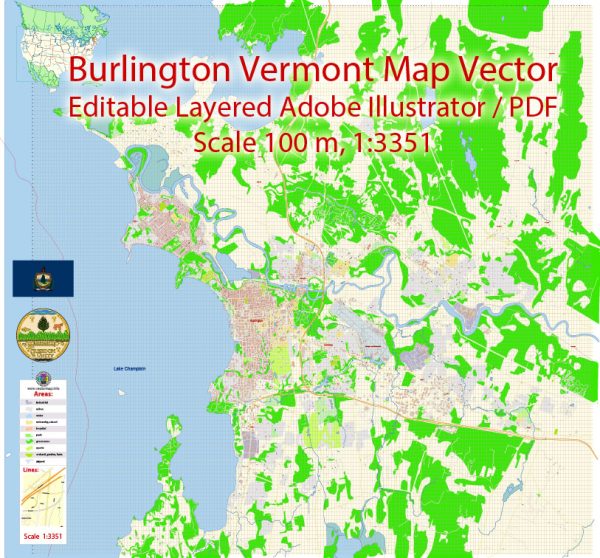Burlington, Vermont, is the largest city in the state and has a rich history of urban development that dates back to the late 18th century. Here’s a description of the city’s urban development history:
- Early Settlement: Burlington was settled in the late 18th century and became a significant port on Lake Champlain. It was incorporated as a city in 1865, and its early urban development was influenced by its strategic location as a trade and transportation hub. The city was named after the Burling family, which had an important role in its early development.
- Industrial Revolution: During the 19th century, Burlington experienced significant growth and transformation, thanks in part to the Industrial Revolution. Industries like lumber, textiles, and manufacturing thrived, and the city’s economy expanded. The waterfront became a vital area for commerce and industry, with mills and factories lining the shores of Lake Champlain.
- Railroad Expansion: The arrival of the railroad in the mid-19th century further accelerated Burlington’s development. It increased trade and provided a means of transportation for goods and people. The train station, which still stands today as the Burlington Amtrak station, played a crucial role in the city’s urban development.
- Architectural Heritage: Burlington’s architectural heritage is rich, with various architectural styles represented throughout the city. From the Greek Revival and Victorian-era buildings in the Old North End to the Art Deco and Mid-Century Modern structures, the city’s architecture reflects its historical development over the years.
- Higher Education: Burlington is home to the University of Vermont, founded in 1791. The presence of the university has been a driving force in the city’s development, contributing to a vibrant academic and cultural community. The expansion of the university over the years has led to further urban development in the surrounding areas.
- Waterfront Redevelopment: In recent decades, Burlington has undergone significant waterfront redevelopment. The city has focused on revitalizing its lakefront area, turning the former industrial sites into recreational spaces, parks, and a bustling commercial district. The Lake Champlain waterfront is now a popular destination for residents and tourists alike.
- Economic Diversification: Over time, Burlington’s economy has diversified beyond traditional industries. It is known for its vibrant arts and culture scene, as well as its reputation as a hub for outdoor enthusiasts, thanks to its proximity to the Green Mountains and Lake Champlain. The Church Street Marketplace, a pedestrian mall with shops and restaurants, has become a central part of the city’s commercial district.
- Sustainability and Environmental Focus: Burlington is known for its commitment to environmental sustainability. In 2009, it became the first U.S. city to source 100% of its electricity from renewable energy. This focus on sustainability has influenced urban development, with green initiatives and bike-friendly infrastructure becoming integral to the city’s planning.
Burlington, Vermont’s history of urban development is a story of economic evolution, adaptation to changing times, and a commitment to preserving its natural beauty while building a vibrant and thriving community. The city’s history is reflected in its diverse architecture, institutions, and its role as a center for culture and commerce in northern New England.


 Author: Kirill Shrayber, Ph.D.
Author: Kirill Shrayber, Ph.D.